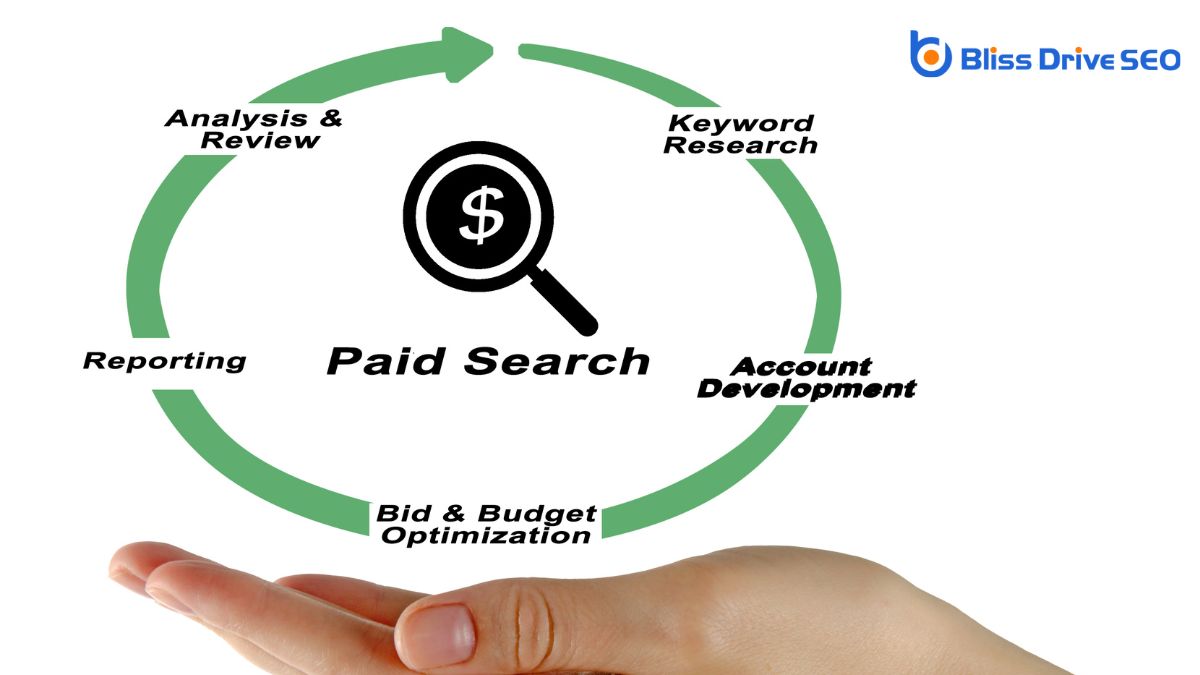Digital Marketing Services
Learn More About Us

When you search for products like "running shoes" on Google, and sponsored links appear at the top labeled "Ad," you're seeing paid searchAdvertising on search engines, where advertisers pay to have their ads appear in search results. marketing in action. Companies use platforms like Google Ads to bid on these keyword phrases so their ads appear when potential customers search for them. This approach connects businesses with targeted audiences effectively. If you want to uncover the secrets behind creating successful paid search campaigns, the information is just ahead.

When you immerse yourself in paid search marketing, you're stepping into a powerful tool that connects businesses with potential customers through search engine advertising.
You're using platforms like Google Ads or Bing Ads to place your business right where people are searching. It's about targeting keywords relevant to your products or services, ensuring that when someone looks for what you offerThe specific product or service being promoted by affiliates., your ad appears prominently.
Understanding how it works involves knowing that advertisers bid on keywords, and the search engine decides ad placement based on factors like bid amount and ad quality.
It's a dynamic process where you monitor and adjust your campaigns to improve results.
You'll find that paid search marketing offers immediate results, measurable ROI, and the ability to reach a highly targeted audience.
To build a successful paid search campaignA set of ad groups sharing a budget, targeting options, and other settings., you must focus on several key components that work together to drive results. Start with setting clear goals to define what you want to achieve. Next, design compelling ad creatives that grab attention and encourage clicks. Creating a well-structured ad groupA collection of ads within a campaign that share a set of keywords and targeting options. helps in organizing your campaign for maximum efficiency. Optimize landing pages to guarantee they're relevant and user-friendly, increasing the likelihood of conversions. Finally, monitor and adjust your budget to get the best return on investment.
Here's a quick overview:
| Component | Purpose | Importance |
|---|---|---|
| Goal Setting | Define objectives | Guides strategy |
| Ad Creatives | Capture attention | Encourages clicks |
| Ad Group Structure | Organize campaign | Maximizes efficiency |
| Landing Pages | Boost conversions | Enhances relevance |
| Budget Management | Optimize ROI | Increases returns |
Keywords play a pivotal role in shaping the success of your paid search efforts, as they directly connect your ads to users' search queries. By carefully selecting the right keywords, you guarantee your ads appear when potential customers are actively searching for products or services like yours.
Start by researching which words and phrases your target audience uses. Tools like Google Keyword Planner help identify high-volume, relevant terms. Remember, it's not just about choosing popular keywords; focus on finding a balance between relevance, competition, and search volume.
Use negative keywordsKeywords that prevent ads from being shown for certain search queries. to exclude irrelevant searches, saving you money. Regularly review and adjust your keyword list to stay aligned with changing trends and user behavior, maximizing your ad campaign's effectiveness and return on investment.
When crafting ad copyThe text or content of an advertisement., you need to grab attention quickly with a strong headline that stands out.
Highlight your product's unique benefits to show why it's the best choice.
Finally, encourage immediate action by including a clear call-to-action that compels potential customers to click.
How do you make your ad stand out in a sea of competing messages? You've got only a few seconds to grab attention, so every word counts.
Start with a powerful headline that speaks directly to your audience's needs or desires. Use action verbs and emotional triggers to spark curiosity or urgency.
Keep your message clear and concise; avoid jargon or complex language that might confuse you. Incorporate numbers or statistics to add credibility and draw the eye.
Consider asking a question to engage curiosity. Make sure your call-to-action is direct and compelling, guiding users to the next step effortlessly.
Showcasing what sets your product or service apart is essential in crafting compelling ad copy. When you highlight unique benefits, you connect with potential customers by addressing their specific needs and desires.
Start by identifying what makes your offering different from competitors. Is it faster, more efficient, or perhaps eco-friendly? Use clear, concise language to communicate these benefits in your ad.
Remember, you're not just selling a product; you're offering a solution to a problem or an enhancement to someone's life. Speak directly to your audience, using words that resonate with them.
Drive your audience to act now by crafting ad copy that encourages immediate action. You want your message to be clear, compelling, and concise.
Use action-oriented words like "buy now," "limited time offer," or "get yours today" to create a sense of urgency. Highlighting deadlines or scarcity, such as "only 5 left," can also spur quick decisions.
Make sure your value proposition is evident. If your ad offers a discount, state it upfront: "Save 20% today!" This direct approach helps potential customers understand the immediate benefits, prompting them to click.
Remember to tailor your language to your target audience. Knowing what motivates them allows you to craft messages that speak directly to their needs and desires, increasing engagementThe interactions that users have with a brand’s content on social media. and conversions.
When setting campaign budgets, you need to align them with your marketing goals and available resources.
Effective bid management is essential to guarantee you're maximizing your return on investment while staying within budget.
Although setting a campaign budget might seem intimidating, it's an essential step in ensuring your paid search efforts are both effective and efficient. Start by determining how much you're willing to spend monthly on your campaign.
It's vital to align this budget with your overall marketing goals and expected return on investment. Consider factors like the cost-per-click in your industry, your target audience, and your competitors' budgets.
Next, break down your monthly budget into daily limits, ensuring you don't overspend too quickly. You can adjust these limits based on performance data.
Monitoring your budget frequently helps you make informed decisions and optimize your spending. Remember, setting a realistic budget gives you control over your expenditures and helps you maximize your campaign's potential.
To master effective bid management, you must understand that both budgeting and bidding strategies play essential roles in your paid search success. Start by setting a realistic budget that aligns with your overall marketing goals. Then, choose a bidding strategy that maximizes your return on investment. Consider automated bidding if you're new or manual bidding for more control. Regularly review and adjust your bids based on performance data.
| Strategy | Pros | Cons |
|---|---|---|
| Automated Bidding | Saves time, easy for beginners | Less control over individual bids |
| Manual Bidding | Full control, precise adjustments | Time-consuming, requires expertise |
| Rule-Based Bidding | Balances control and automationUsing software to send emails automatically based on predefined triggers and schedules. | Complexity in setup and maintenance |
Understanding how well your paid search campaigns are performing is essential for optimizing marketing strategies and improving ROI.
To effectively measure and analyze performance, you need to focus on key metrics and actionable insights. Here's how you can do it:

When crafting a successful paid search strategy, an exemplary case study can offer valuable insights. Consider how Airbnb enhanced its visibility and bookings through a well-executed campaign. They targeted specific keywords potential guests might use, like "unique stays" or "vacation rentals."
By optimizing their ads and using compelling visuals, Airbnb captured attention and drove conversions.
You can learn from Airbnb by focusing on audience intent. They didn't just select keywords; they researched what their audience was genuinely searching for.
Airbnb also tested different ad copies to discover which resonated best. This trial-and-error approach helped them refine their strategy over time.
In a successful paid search strategy, you've learned that understanding your audience and using targeted keywords is essential. You've crafted compelling ad copy that grabs attention and drives clicks. By carefully managing your budget and employing smart biddingA set of automated bid strategies that use machine learning to optimize for conversions or conversio... strategies, you've maximized your return on investment. Analyzing performance metrics has allowed you to refine your approach continuously. With these insights, you're equipped to implement a paid search campaign that effectively meets your marketing goals.
